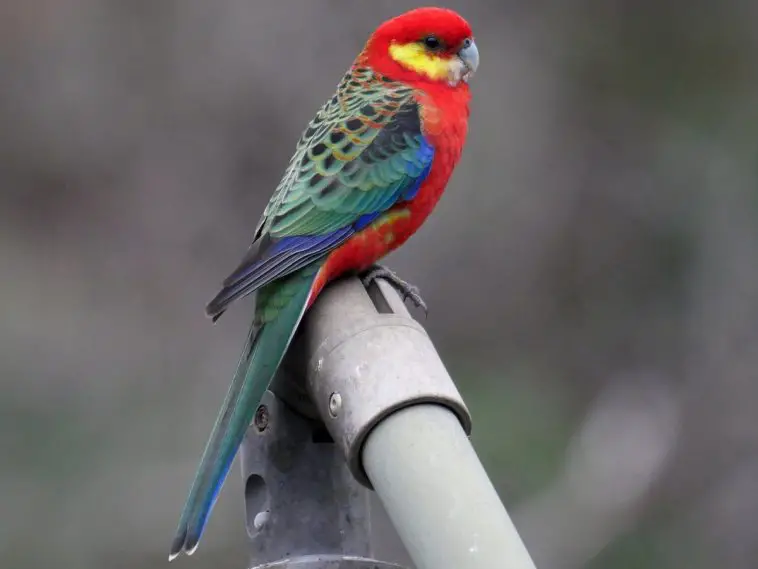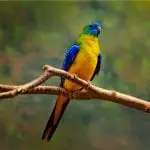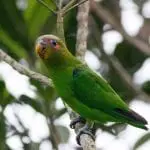Scientific Facts
| Common Name | Western Rosellas or Yellow-cheeked Rosellas |
| Scientific Name | Platycercus icterotis |
| Size | 26cm (10 in) |
| Life Span | 25-40 yrs |
| Habitat | Found in open and partly cleared Eucalypt woodland and forest, riverine forest, farmland, orchards, towns, clearings, roadsides, gardens, cultivated areas, pastures, wooded savanna and shrubland |
| Country of Origin | Australia |
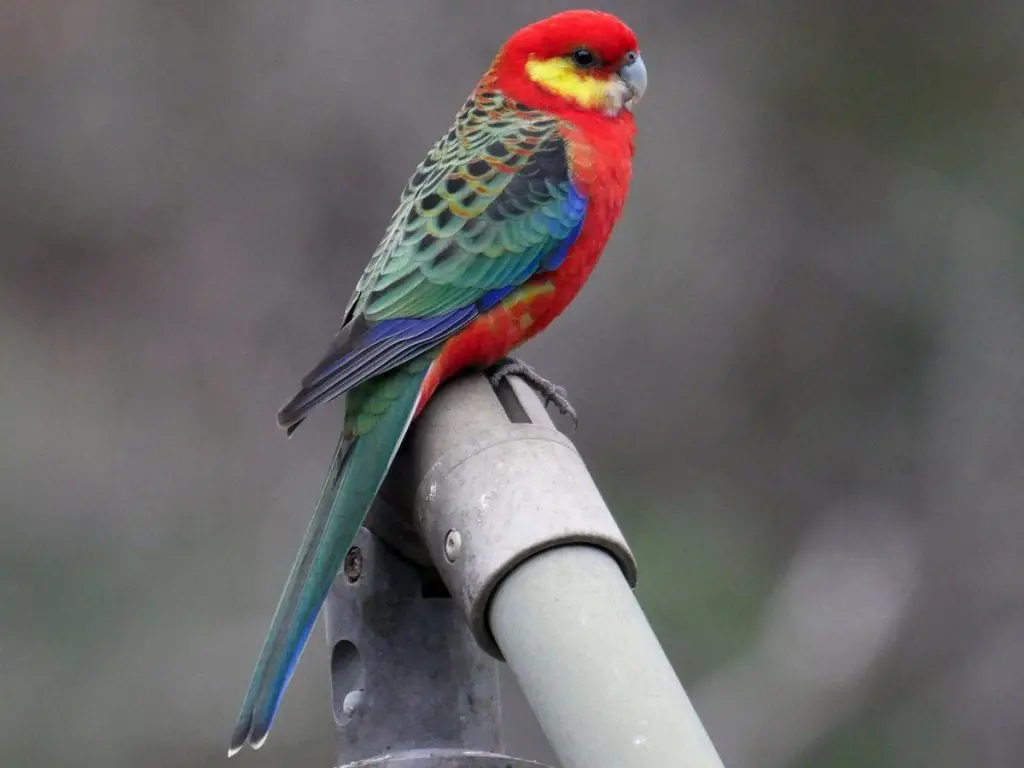
Acknowledged for its eagerness to breed in confinement and its magnificent color, the Western Rosella is a familiar famous breeder’s bird.
There are two subspecies of the Western Rosella, both of them indigenous to southwestern Australia. They can profit from mosaic scenery modified for such ideas as to give golf courses or parks, although wholesale demolition of their landscape is dangerous.
Physical Description
Western Rosellas average 25 – 26 cm or 10 inches in length – including the long tail.
This Rosella has strikingly bright feathers. The under tail-coverts, abdomen, thorax, and crown are red. The lores (the areas between the eyes and beak on the side of a bird’s crown), cheeks, and chin are yellow. The back feathers and neck are black with green lining; likewise, somewhat with red borderline in some maturer birds. The collar plumages are black, shifting green towards ends. The inner center wing-coverts are black. The tip of the appendages and outer center wing-coverts and under wing-coverts are violet-blue.
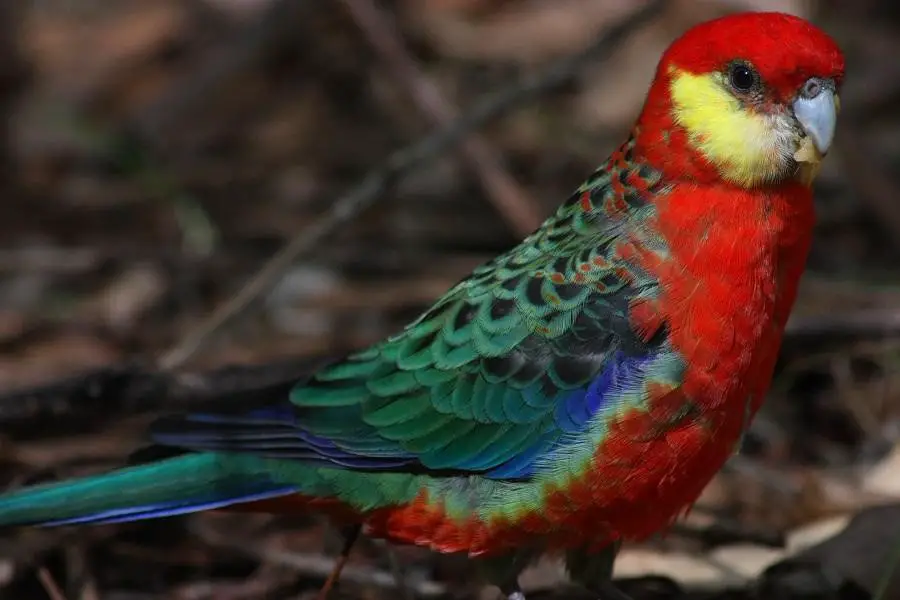
Inferior-coverts are green, including violet-blue outer mats. Secondaries (smaller, upper “wing” plumages) are green with thin greenish-blue borderline to outer plumages. The outer mats are rich violet-blue at the bottom of primaries and initial wing plumages. The lower rear and upper tailpiece-coverts are green. The upper surface of the core tail-feathers is deep green. The outer tail-feathers are light blue with a deep blue foundation and light points. The tailpiece underneath was light blue. The beak is pale greyish-horn shade. They possess a thin periophthalmic hoop that is grey to a dull grey. The irises are deep brown, and the feet are greyish-brown.
The female’s feathers are a darker red. Her neck, head, thorax, upper belly, and lower chops are green with dense dark red fringe. Her rear is dull black; each plumage mainly bordered with green. The outer core wing-coverts are green-shaded violet-blue. The secondary-coverts and outer secondaries possess more limited violet-blue to the outer nets. The outer nets at the bottom of preexistence and main wing plumages are dark violet-blue. Her lower spine and upper ends-coverts are green. The upper side of the core tail-plumes is dull deep green. The outer tail-feathers are light blue with deep green foundation and light tops. The whitish below wing-bands is present.
Juveniles are essentially green to olive-green and with orange-red plumage on temples, thorax, stomach, and under tail-coverts. Juvenile males hold more red, especially chest plumages, which are orange-red. The yellow jowl spot is chiefly absent. The pale beneath wing-band is present. Juvenile birds achieve the grown-up coloration following their second molt – when they are nearly 12 to 16 months old. At that point, they likewise become reproductively older.
Geographical Range
The Western Rosella is solely discovered in the south-west of Western Australia. There are two sub-species, with the nominate, icterotis, confined to the south-west coast, and the other, xanthogenys, found in the wheat belt.
Taxonomy
Species:
- English: Red-backed Western Rosella
- Dutch: Roodrug Stanley Rosella
- German: Rotrücken Stanleysittich
- French: Rosella de Salvador
- Distribution: The interior of south-western Australia
Habitat
Western Rosellas are observed in unrestricted eucalypt woodland and woody regions, containing planted farms and orchards. The designate icterotis is seen in elevated rainfall zones and the other subspecies, xanthogenys, in more desert forest, with a scrub understorey.
Common Behavior
The Western Rosella is deemed as the least competitive of the Rosellas, but it’s still a Rosella. You cannot accommodate a single pet or a breeding couple with other birds. Each pair or pet should own its aviary.
All birds are individuals, and there are stories of pet-quality Western Rosellas who acquire to whistle and adore to engage with playthings. Some hand-served juvenile birds, if they are supervised and engaged with regularly, sustain their pet character. Though, a few hand-served birds become even more dynamic than the parent-fostered birds, conceivably since they hold no dread of people. Some may grow grinders whatever you create.
Produce a strategy for what appears if your pet regresses to its natural environment when it becomes more grown. Do you possess sufficient place to give it with aviation where it can be appreciated for its elegance, and take vigorous training? If you can relish a wonderful being who doesn’t want to be touched by you or anybody else, then the self-sufficient, moderately aggressive Western Rosella may be excellent for you. However, if you’re seeking for a lifetime collar bird, you’re getting an enormous risk if you prefer a Western Rosella.
Speech and Sounds
These dynamic, energetic birds adore causing their sounds detected. Not a strong side of Rosella Parakeet, but talking and imitation are present. What they prefer, however, is to be boisterous, with a broad array of tunes, whistles, and cries. Most of the course, these monotonous, but harmonious songs are employed to verbalize their demands or something that is not based on their preferences. They’re not constantly loud, though, and during specific events will be calm and tranquil. Yet, their vulgar characteristics deliver them an inferior option for studio living.
This parrot is noted as a symphonic whistler, and even if it becomes somewhat savage, it may be ready to satisfy you with its melody. If you can play auditory snippets of whistled hymns or know how to whistle, your Western Rosella can acquire to travel back and forth beside you.
Diet and Feeding Habits
The Western Rosella is not difficult to satisfy. If your rosella was fostered to appreciate a high-class industrial grain, then stand firm, while supplementing a diced salad rich in legumes on the side. If your parakeets are from a more classical environment, then provide the choicest quality grain you can. One prosperous breeder suggests dropping the tiny grain blends ahead of the birds at all periods with the aim that they won’t concentrate too extremely on the savory high fatty grains like the sunflower. Again, you must supply constant portions of diced salad. It is profoundly desirable to consistently germinate some of the seed and give the moistened, germinated seed. Green millet sprays are an exceptional setup.
A pet Western Rosella may be eager to accompany you at a feast for more diverse nutrition, though never let any parakeet attempt meals that are lethal to them, such as alcoholic beverages, undercooked poultry, or fish, chocolate, or avocado. A couple of aviary birds must be provided healthier nutrition throughout the breeding period, with regular portions of high-quality pellets, fresh vegetables, and soaked seeds.
Reproduction and Life Cycle
In their common territory, the breeding period is determined by rainfall as well as the region of their residence area.
The breeding season begins in Australia from September through March, but commonly in March or April.
The courting male will bend forward low on the roost while enunciating out the coupling cries. The drawn hen will perform the equivalent. This is commonly accompanied by joint feeding and then the concrete action of coupling.
Wild Rosellas generally dwells near/ adjacent to water, in the hollows of either living or dead trees, commonly in posts and hollow stumps, or eucalypts. The dwelling hollow is usually over 1 m (3 feet) deep and found up to 30 m (100 ft) above the terrain.
The nest basement is usually treated with wood particles. The hen solely nurtures the embryos; at the same time, the male serves her and supports to give meals for the juvenile. In the native, they commonly present 1 – 2 offspring a period.
Lifespan / Age of Maturity
Rosellas can be assumed to exist 15 or longer years. Females attain generative development when they are approximately 18 months old, while males can favorably propagate when they are 2 – 3 years old.
How to Breed
The breeding customs of the western rosella hold not been well-examined; hens access dwelling holes from July, with males taking so from mid-August. Embryos are produced from late August to late September and bear late September to late October. Juvenile birds leave the nest (fledge) late October to mid-November. The class in research at Wickepin and Dudinin (Kulin Shire) was witnessed to start possession of den localities in July, the habit of the hen being served by the male being set in the week before producing the offspring.
The western rosella dens in holes and spout-formed chambers of dead and living trees, commonly eucalypts and most usually wandoo and karri. The trees are usually old and large, with one research confirming a standard age of 290 years for the host tree. Eucalypts are a chosen tree species in which to produce their embryos, the prevailing Eucalyptus marginata of jarrah wood, or in the towering forest wood karri, but they particularly prefer wandoo. Cracks in tree pieces and barrier pillars are also employed. Other trees were chosen to combine eucalypts such as moitch (flooded gum), yandee E. loxophleba (york gum), wurak, and marri.
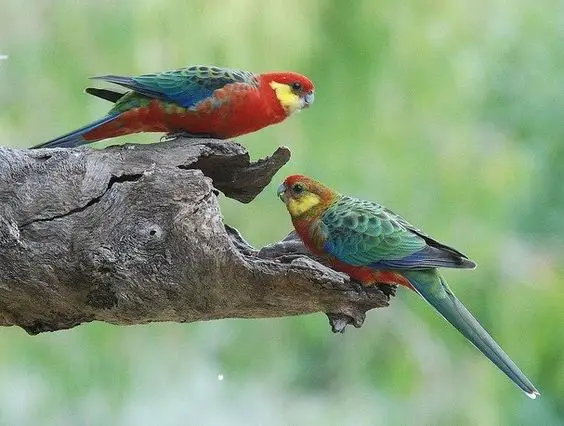
The holes are commonly a meter or about broad, and those that possess particles generated by dull pests in the ground are favored. The young are deposited straight onto the wood particles or ruins in the hollow chosen; the place is otherwise unembellished. The adamantine representation of the den place, associating extent, depth, and access measurement utilized by the species, was involved in research of animals residing tree hollows in the jarrah woodlands and designed to help in deciding the amount of proper territory transferred and continuing after lumbering. The cradle place is generally a spout formed the entrance, between 1.8–4.1 inches (45–105 millimeters) in diameter, at a pit between 14–59 inches (0.35–1.5 meters) in depth pointing to a green limb.
One offspring is generally raised per breeding period, though frequently two are in confinement. The clutch measurement is between two and seven (seldom nine) embryos, with the standard being approximately six. The crust has a sparse shimmer, and the shape is oval. The standard size of embryos is 0.87 by 1.02 inches (22 by 26 millimeters). Sizes from a specimen of 29 eggs yielded a size span of 0.93–1.09 inches (23.5–27.7 millimeters) × 0.78–0.89 inches (19.9–22.5 millimeters). Solely the female nurtures the eggs, neglecting the cradle in the daylight and midday to consume food obtained by the male. The male stays adjacent to the place, filling at terrain level and traveling to an upper twig to summon when providing to the reproducing female.
The juvenile arises from the embryo following an incubation phase of 23 to 25 days and abandons the cradle roughly five weeks following that. The fledglings have yellowish beaks and illustrate down at the back that is light grey after they arise from their egg. The attainment percentage of egg numbers enduring to grow self-sufficient individuals, while believed to be periodically changeable, was covered in one review to be 72%.
Pet Care
A couple of Western Rosellas are generally accommodated in a huge market aviary, with suitable security in position to conceal toward disease-carrying mosquitoes and larger pests such as rats, raccoons, and opossums. They haven’t counted a breed that worries greatly concerning playthings, though they will enjoy proper roosts installed to provide them loads of scope to circumnavigate. They are notably intrusive and mustn’t be proposed to bestow the flight with some different birds. Surveillance regulating set-up, accompanying the suitable bolts, must prevent burglars.
Before you pick a Western Rosella as a family pet, you may need to have a practical appearance at how much capacity you possess. With their long delicate tails and their eagerness to practice by gliding rather than by engaging with playthings, you must apparently be equipped to provide a long flight that takes over a huge place. If your bird stays gentle, you can reasonably take away with a powder-smeared metal enclosure 91 x 60 x91 cms with no larger than 1.2cms pole spacing, with variously sized roosts installed to support traveling the expansion of the enclosure. If the bird does regress to living a distant, primitive beauty who favors being stared at but not handled, then you must provide a much greater flight. You may want to contemplate producing the precise flight custom-built.
Species-Specific Problems
Western Rosellas consume a portion of their feeding course on the terrain and therefore are consequently vulnerable to fungal infections and intestinal worms. These are comparatively efficiently administered, though, solely by sustaining a fineness of cleanliness. Enteritis may likewise become a predicament if the bird is served great masses of leafy foods. This is especially so if leafy food is not detached after each day.
Availability
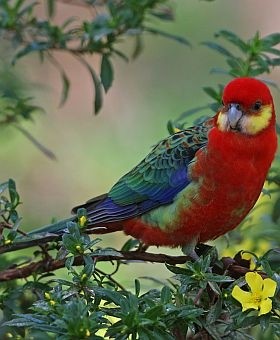
Although two are most generally accessible as pets — the crimson rosella, and the Eastern rosella or the golden-mantled – there are eight species of rosella. Rosellas are more expected to be accessible from an avian-specialty shop or a bird breeder.
Western rosellas are a popular bird for zoological gardens and in aviaries, presenting the desirable features of similar species without the notoriety for hostility and loud vocalization.
Economic impacts
Western Rosellas may destroy fruit in farms and be shortly eliminated as pests. They are now preserved from extinction, except with particular permission. They are perhaps decreasing in the corn area from the destruction of the forest.
Conservation
This breed has a moderately wide-scale and therefore, does not address the gates for Vulnerable following the area size standard (Extent of Occurrence <20,000 km2 consolidated with a declining or varying field size, territory quality/extent, or distribution size and a small fraction of sections or harsh destruction).
Although the distribution inclination seems to be declining, the pace of slump is not considered to address the gates for Vulnerable beneath the distribution inclination pattern (>30% slump covering ten years or three periods).
The population size has not been established, but it is not considered to address the gates for Vulnerable following the distribution size standard (<10,000 older individuals with a progressive deterioration measured to be >10% in ten years or three generations, or with a detailed population arrangement). For these analyses, the species is assessed as Least Concern.
FAQs
Do rosellas mate for life?
Rosellas mate for life. The female judges and makes the nesting site, normally a hole in a eucalypt tree.
Do rosellas eat fruit?
Rosellas eat insects and insect larvae, nectar, shoots, buds, flowers,
nuts, fruits, and seeds.
Can rosellas eat a banana?
Rosellas usually favor consuming non-native fruits such as mangoes, oranges, blackberries, and apples.
Are rosellas noisy?
Rosellas are known for their harsh, screaming sounds (although articulating less commonly than some other parrot species) and inclination to be massive grinders.
Are rosellas good pets?
While rosellas might not be favored to snuggle or desire to be caressed like other parrots, they can be friendly if they are constantly associated with.
How many eggs do rosellas lay?
Female rosellas started reproducing in late September or early October, producing an average of 5.3 ± 0.1 (s.e.) embryos at 1–4-day intervals.
Can rosellas live with budgies?
In their wild Australian home, these two species share the same habitat.

